The Signature at Treetops Resort

About
There are 81 holes of championship golf at Treetops Resort. There are three courses designed by Rick Smith as well as one designed by Robert Trent Jones and another by Tom Fazio. A par-3 course is also available. The Signature Course was Rick Smith’s first 18-hole course. The golf course features undulating greens and wide, forgiving fairways, forming a layout that appeals to players of all skill levels. The rolling terrain offers some interesting slopes that cause some tricky lies, especially on the seemingly easy par-5 15th. This hole features a severe uphill approach and narrow, double-tiered greens. Depending on the pin location the approach will require two to four extra clubs. The golf courses are unique from one another but they all share the dramatic views and challenging contours provided by the scenic hills.
| Tee | Par | Length | Rating | Slope |
|---|---|---|---|---|
| Black | 70 | 6653 yards | 72.6 | 136 |
| Black/Blue | 70 | 6410 yards | ||
| Blue | 70 | 6285 yards | 71.1 | 133 |
| Blue/White | 70 | 6071 yards | ||
| White | 70 | 5863 yards | 68.9 | 129 |
| White/Gold | 70 | 5588 yards | ||
| Gold (W) | 70 | 5413 yards | 72.2 | 137 |
| Gold | 72 | 5413 yards | 66.8 | 125 |
| Gold/Red (W) | 70 | 5005 yards | ||
| Red (W) | 70 | 4604 yards | 66.9 | 125 |
| Hole | 1 | 2 | 3 | 4 | 5 | 6 | 7 | 8 | 9 | Out | 10 | 11 | 12 | 13 | 14 | 15 | 16 | 17 | 18 | In | Total |
|---|---|---|---|---|---|---|---|---|---|---|---|---|---|---|---|---|---|---|---|---|---|
| Black M: 72.9/140 | 447 | 176 | 467 | 186 | 421 | 512 | 416 | 190 | 411 | 3226 | 556 | 175 | 423 | 440 | 418 | 485 | 368 | 199 | 363 | 3427 | 6653 |
| Black/Blue M: 72.0/140 | 447 | 176 | 443 | 167 | 392 | 512 | 378 | 175 | 411 | 3101 | 523 | 164 | 388 | 420 | 418 | 485 | 368 | 188 | 363 | 3317 | 6418 |
| Blue M: 71.0/139 | 422 | 160 | 443 | 167 | 392 | 503 | 378 | 175 | 394 | 3034 | 523 | 164 | 388 | 420 | 389 | 461 | 361 | 188 | 343 | 3237 | 6271 |
| Blue/White M: 70.1/138 | 402 | 160 | 433 | 149 | 364 | 503 | 378 | 154 | 394 | 2937 | 523 | 145 | 336 | 392 | 389 | 461 | 361 | 164 | 343 | 3114 | 6051 |
| White M: 69.2/135 W: 75.4/145 | 402 | 144 | 433 | 149 | 364 | 496 | 354 | 154 | 364 | 2860 | 492 | 145 | 336 | 392 | 361 | 438 | 347 | 164 | 308 | 2983 | 5843 |
| White/Gold M: 67.7/134 W: 73.9/143 | 376 | 144 | 411 | 149 | 324 | 496 | 317 | 128 | 364 | 2709 | 492 | 128 | 305 | 326 | 361 | 438 | 347 | 148 | 308 | 2853 | 5562 |
| Gold M: 66.8/131 W: 72.8/140 | 376 | 142 | 411 | 114 | 324 | 481 | 317 | 128 | 344 | 2637 | 453 | 128 | 305 | 326 | 339 | 414 | 342 | 148 | 295 | 2750 | 5387 |
| Gold/Red W: 70.6/134 | 354 | 117 | 354 | 114 | 324 | 382 | 317 | 113 | 344 | 2419 | 453 | 113 | 265 | 297 | 339 | 414 | 342 | 90 | 295 | 2608 | 5027 |
| Red W: 67.9/131 | 354 | 117 | 354 | 114 | 283 | 382 | 284 | 113 | 266 | 2267 | 453 | 113 | 265 | 297 | 339 | 349 | 254 | 90 | 199 | 2359 | 4626 |
| Handicap | 7 | 17 | 3 | 15 | 1 | 5 | 9 | 13 | 11 | 4 | 14 | 10 | 2 | 8 | 6 | 18 | 16 | 12 | |||
| Par | 4 | 3 | 4 | 3 | 4 | 5 | 4 | 3 | 4 | 34 | 5 | 3 | 4 | 4 | 4 | 5 | 4 | 3 | 4 | 36 | 70 |
Course Details
Rentals/Services
Practice/Instruction
Policies
Food & Beverage
Snacks, RestaurantAvailable Facilities
Clubhouse, Meeting Facilities, Banquet FacilitiesReviews
Reviewer Photos
One of Gaylord's Best
Many people believe that Treetops Golf Resort in Gaylord put Northern Michigan on the map as a great golf destination. Although there are several golf resorts in the area with multiple courses, Treetops emerges each year as one of the most recognizable golf resorts in the state. With 81 holes of spectacular golf at two locations (Treetops North is about a 7-minute drive), 226 guest rooms and suites, a spa, a salon, and more than 25,000 sq. ft. of meeting space, it’s easy to see why Treetops Resort is a popular venue for golf getaways, weddings, and business conferences.
If golf’s not your game there are plenty of other activities including mountain biking, fly fishing, tennis, disc golf, and horseback riding. When the white stuff starts to fall, Treetops transforms into one of Northern Michigan’s top ski resorts, with 23 expertly groomed ski runs, and 14 kilometers of cross-country skiing and snowshoeing trails.
Over the years Treetops has received its share of accolades from the golf world. Golf Magazine awarded them its Silver Medal Award as one of the finest resorts in the United States, 7-times. In 2002, Treetops was ranked #32 on Golf Digest’s list of “America's Top 75 Golf Resorts”, and in June 2000, Conde Nast Traveler recognized them as a “Top 50 International Resorts.” Pinehurst and Pebble Beach were the only two golf resorts ranked higher that year. Year in and year out Treetops is awarded at least 4 stars by Golf Digest’s Places to Play. And with courses designed by three of the industry’s top golf architects – Tom Fazio, Robert Trent Jones Sr., and Rick Smith – you’re sure to be challenged.
For my money, there are two other qualities necessary for a golf resort to earn consideration (besides exciting golf): good dining and comfortable accommodations. On either point, Treetops does not disappoint. Treetops offers three restaurants on the main property that are all located within steps of each other: Legends on the Hill, Hunter's Grille, and the Sports Bar. The food is outstanding and, in many respects, unique. Hunter’s Grille offers an ever-evolving menu of eclectic cuisine and spectacular views from the top of the ski hills. Legends on the Hill has a pasta dish that features a giant elk meatball and handmade herb pappardelle pasta covered in a rich tomato sauce and served with shaved Parmesan, and garlic toast. There’s also fresh Michigan rainbow trout and a Sous Vide Pork Chop that is incredibly delicious.
At the Sports Bar, you can indulge in your favorite made-to-order pizza or enjoy a hot and spicy Nashville Hot Chicken Sandwich. The Southfork Ranch Steak Sandwich is delicious too; 8oz of prime rib, sauteed onions, fresh spinach, and garlic aioli, served on fresh rosemary Herb Bread.
The Jones Tavern at Treetops North is open for breakfast, lunch, and dinner from 7 a.m. – 8 p.m. It’s primarily a grab-and-go menu with items like a Signature Burrito, Smith Breakfast Sandwich, the Fazio Grilled Ham and Cheese, and the Traditions Southwest Wrap.
Bar 81 is located on the main floor of the lodge just past the reception area. There are several TVs, making it a perfect spot to relax with your friends, recap the day, and watch your favorite sports teams. They even offer a light menu, something to snack on between sips of your favorite adult beverage.
As far as the rooms in the lodge go, the rooms are some of the largest I’ve stayed in. Each room is equipped with a refrigerator, microwave, and coffeemaker as well as a large flat-screen TV, and bathrooms with huge walk-in showers. In the lodge, you’ll find an indoor pool, hot tubs, and a fitness center as well as the Treetops Spa.
The newest addition to the Treetops lodging collection is the Jones Cottages, located on the 4th hole of the Masterpiece. Each cottage sleeps eight people comfortably, making them perfect for small groups and outings. All are outfitted with modern amenities and the two-floor layout provides added space and unbeatable views.
Treetops' other three courses can be found at Treetops North, about a 7-minute drive up the road. The Signature was the second 18-hole layout built on the resort property. It was also the first golf course design for Rick Smith who then went on to design the Tradition Course and Threetops. Smith used the insight and knowledge he gained from his numerous trips to Scotland and Ireland to help him shape the courses, giving them the look and feel of some of the world’s best courses.
Golfweek Magazine recently recognized the Signature Course as one of the Top 200 Resort Courses in the United States. features rolling hills, sand traps, and dramatic elevation changes, both up and down. With all of its magnificent views, The Signature Course is the most photographed course at Treetops and is the overwhelming favorite of both locals and visitors.
Treetops Resort is located about 5 miles east of Gaylord and only 10 minutes from I-75. With great golf, fantastic dining, and spacious, comfortable rooms, you won’t go wrong in choosing Treetops as your next golf getaway destination.
One of Gaylord's Best
Many people believe that Treetops Golf Resort in Gaylord put Northern Michigan on the map as a great golf destination. Although there are several golf resorts in the area with multiple courses, Treetops emerges each year as one of the most recognizable golf resorts in the state. With 81 holes of spectacular golf at two locations (Treetops North is about a 7-minute drive), 226 guest rooms and suites, a spa, a salon, and more than 25,000 sq. ft. of meeting space, it’s easy to see why Treetops Resort is a popular venue for golf getaways, weddings, and business conferences.
If golf’s not your game there are plenty of other activities including mountain biking, fly fishing, tennis, disc golf, and horseback riding. When the white stuff starts to fall, Treetops transforms into one of Northern Michigan’s top ski resorts, with 23 expertly groomed ski runs, and 14 kilometers of cross-country skiing and snowshoeing trails.
Over the years Treetops has received its share of accolades from the golf world. Golf Magazine awarded them its Silver Medal Award as one of the finest resorts in the United States, 7-times. In 2002, Treetops was ranked #32 on Golf Digest’s list of “America's Top 75 Golf Resorts”, and in June 2000, Conde Nast Traveler recognized them as a “Top 50 International Resorts.” Pinehurst and Pebble Beach were the only two golf resorts ranked higher that year. Year in and year out Treetops is awarded at least 4 stars by Golf Digest’s Places to Play. And with courses designed by three of the industry’s top golf architects – Tom Fazio, Robert Trent Jones Sr., and Rick Smith – you’re sure to be challenged.
For my money, there are two other qualities necessary for a golf resort to earn consideration (besides exciting golf): good dining and comfortable accommodations. On either point, Treetops does not disappoint. Treetops offers three restaurants on the main property that are all located within steps of each other: Legends on the Hill, Hunter's Grille, and the Sports Bar. The food is outstanding and, in many respects, unique. Hunter’s Grille offers an ever-evolving menu of eclectic cuisine and spectacular views from the top of the ski hills. Legends on the Hill has a pasta dish that features a giant elk meatball and handmade herb pappardelle pasta covered in a rich tomato sauce and served with shaved Parmesan, and garlic toast. There’s also fresh Michigan rainbow trout and a Sous Vide Pork Chop that is incredibly delicious.
At the Sports Bar, you can indulge in your favorite made-to-order pizza or enjoy a hot and spicy Nashville Hot Chicken Sandwich. The Southfork Ranch Steak Sandwich is delicious too; 8oz of prime rib, sauteed onions, fresh spinach, and garlic aioli, served on fresh rosemary Herb Bread.
The Jones Tavern at Treetops North is open for breakfast, lunch, and dinner from 7 a.m. – 8 p.m. It’s primarily a grab-and-go menu with items like a Signature Burrito, Smith Breakfast Sandwich, the Fazio Grilled Ham and Cheese, and the Traditions Southwest Wrap.
Bar 81 is located on the main floor of the lodge just past the reception area. There are several TVs, making it a perfect spot to relax with your friends, recap the day, and watch your favorite sports teams. They even offer a light menu, something to snack on between sips of your favorite adult beverage.
As far as the rooms in the lodge go, the rooms are some of the largest I’ve stayed in. Each room is equipped with a refrigerator, microwave, and coffeemaker as well as a large flat-screen TV, and bathrooms with huge walk-in showers. In the lodge, you’ll find an indoor pool, hot tubs, and a fitness center as well as the Treetops Spa.
The newest addition to the Treetops lodging collection is the Jones Cottages, located on the 4th hole of the Masterpiece. Each cottage sleeps eight people comfortably, making them perfect for small groups and outings. All are outfitted with modern amenities and the two-floor layout provides added space and unbeatable views.
Treetops' other three courses can be found at Treetops North, about a 7-minute drive up the road. The Signature was the second 18-hole layout built on the resort property. It was also the first golf course design for Rick Smith who then went on to design the Tradition Course and Threetops. Smith used the insight and knowledge he gained from his numerous trips to Scotland and Ireland to help him shape the courses, giving them the look and feel of some of the world’s best courses.
Golfweek Magazine recently recognized the Signature Course as one of the Top 200 Resort Courses in the United States. features rolling hills, sand traps, and dramatic elevation changes, both up and down. With all of its magnificent views, The Signature Course is the most photographed course at Treetops and is the overwhelming favorite of both locals and visitors.
Treetops Resort is located about 5 miles east of Gaylord and only 10 minutes from I-75. With great golf, fantastic dining, and spacious, comfortable rooms, you won’t go wrong in choosing Treetops as your next golf getaway destination.
Great Course
The course was in awesome shape. Greens were rolling quick and smooth. I was very impressed with the layout and the amount of fun that I had playing this course.
Second Best of the Treetops Courses
I had the chance to play all five Treetops courses in the past week on two Group Golfer Vouchers. After playing them all, Signature is my second favorite behind Premier.
Aside from some rocks in the bunkers and tree damage from a huge storm that rolled through two days before, the course was in very good shape. The course had already started cleaning up the tree damage when we were there and it only really affected play on one hole the entire day. The greens were slower than usual, but rolled nicely. There were a few brown spots on the edges of greens, but now that the weather has cooled down, those are probably gone.
The course is really well designed.There a lot of very unique holes that are visually appealing and a good test of golf as well. There are scenic views, major elevation changes, and difficult greens throughout the course. It is one of the tougher par 70s you will find.
Overall, Treetops is a great resort and Signature is an example of that.
A Beautiful, Rare Construct. Highly Challenging Course.
This was the second year in a row that I joined some buddies to play Treetops. They had been going for years and they claimed that I'd be in for something I've never seen before and that I would love it. They were right.
If you love golf, you will love all of Treetops for its views, variety, and above all, some of the most challenging greens that you will ever experience. The most difficult among them you will find at Rick Smith's Signature Course. How challenging? Well, One of the best golfers in our group who is about a 13 handicap took a 5 putt on the 1st hole and endured eight 3 putts on his way to shooting a personal worst (a certain number over 100). It just wasn't his day and he was left beyond frustrated.
He and others will call the Signature's greens "gimmicky" and I cannot argue otherwise. If out of position, you WILL find there are literally almost impossible putts that will absolutely run off the putting surface and far away from your intended target.
On the other hand — at a 15 handicap — I managed to shoot 90 on the same day. I did this by managing my approach shots, away from bunkers, and pitching/chipping close and leaving the ball in position beneath the pin. (Nine 1 putts and only two 3 putts) with only 6 fairways hit and just one green in regulation So go figure and make of it what you will.
At any time, a course just is what it is and it's the same for all players (from the same tee box) There is a very good reason why this par 70 course has a rating of 71 and slope of 139 from the blue tees at only 6,285 yards. It's just super difficult!
Just know that if you aren't a scratch golfer (or better), you're almost certainly going to take a bigger number here than you are comfortable with, and I hope that you are able to appreciate and enjoy the difficulty and the unique experience the Architect, Rick Smith, was able to deliver. These diabolical undulations are an incredibly rare treat that is immensely difficult to plan, build and maintain. So as you are taking your third fourth or even fifth putt, think about this, laugh about it as your friends laugh with you and enjoy!
Enjoyable but slightly underwhelming
I came into my round hearing great things about the Signature course, but I walked away feeling a little underwhelmed. There are some good holes, but there are also some that are pretty pedestrian. The par 3s seemed particularly weak. The par 4s, however, were pretty fun for the most part. The variety between them was good. If you're looking for a round with a cart and lots of downhill tee shots, you'd be happy playing here. If you're concerned with architecture, there are some better courses in Michigan.
So sick. Caught me by surprise. Top 100 Public You Can Play
If this course was appropriately rated, it would be my 11th top 100 course I’ve played. So legit. Conditioning is FLAWLESS.
I will say that you don’t have to be a bomber and the fairways are most definitely generous but you have to have a good idea of where the stick is on the green. Some of the toughest putting surfaces anywhere. But the course isn’t long so you are able to always have a shot. I shot a 78 and I’m a 7.4 handicap. Had 4 birdies hit 6 doubles and 8 3 putts. Once you’ve seen the greens you’ll know why. It’s a well manicured Tobacco Road. Just so sick.
Hotel not worth it
We stayed at Tree Tops Resort for our anniversary trip away and golfed two rounds of golf. The courses had some nice elevation views and shots. The staff at the 2 courses we played at were very nice. The ranger was really nice and informative about the pace as it was very slow. But that's about the nicest thing I've got to say about this whole place. The hotel rooms were clean but not impressive at all. The door jams on the outside belcony were falling off. The door to out room didn't shut all the way and you could hear everything from the hallways. The beds were not comfortable. The food at the three restaurants that are at the hotel was way overpriced and not good. The only good part of the food was breakfast because we had free vouchers. The waiter at the hunters had no clue about the products he sold and once he gave us one drink we never seen him again and had to go to the bar to get out tab. I could go on and on but I won't. I just know that for me to spend 1000.00 to stay and play I definitely do not feel it was worth that kinda money. Won't be back
The Avocado of the North
Brought 16 gentlemen out to play this track as we had heard great things and I tell you what, we love avocados.
Great layout and in fantastic condition. The fellas and females know what they're doing at the entire TreeTop facility.
Fairly open so let that big boy eat and watch them fly.
Somewhat hard to find on the gps to get to the facility, rectify that please.
Great course with fantastic views
Not quite as challenging as Masterpiece at same resort but a really good course. The weather was perfect and pace of play was just under the expected 5 hours. As other courses at Treetops: rolling hills, sand traps, and elevation changes are the name of the game. Fantastic place, great conditions, and makes me wish I lived closer.
Treetops Resort - Signature
The Good: Extremely unique, interesting layout from longtime instructor Rick Smith is the perhaps the most complete golfing experience at Treetops. Great course conditions from tee through the green. A layout with very limited water but significant elevation changes, winding through woodlands and rolling hills of northern Michigan. Very open off the tee but terrifying around the greens. Some of the most undulating greens you will find. Many strong, difficult Par 4's and risk-reward Par 5's. Very good on-course amenities that include restroom areas and half-way houses. One of the best resort practice areas in the Midwest includes a cool putting course. Strong service and good clubhouse with mini-restaurant. Great value for upstate Michigan resort golf at $100 with cart and range balls.
The Bad: Difficult to nit-pick, but the lack of GPS is a negative. Not as much variation in the Par 4's compared to the Fazio and Masterpiece courses.
The Verdict: The Smith course is arguably the most visually threatening yet enjoyable course at the Treetops resort. Best conditioned of the four 18-hole courses and perhaps the best course in the Gaylord area.
Best Hole: The long, downhill Par 4 3rd is the epitome of the Treetops Resort and Signature course: Huge elevation change from the tee to a large landing area that requires a long-iron/hybrid approach to a demonic two-tiered green.
Slow Play
I love this course (Smith). But the experience was ruined by the slow play. There are zero rangers on the course and the staff seemingly doesn't care about you once you tee off. Of course, I expected slower play during Labor Day weekend. However we were headed for a 6 hour round (and darkness) when we finally walked off the course after skipping around to find open holes and playing a makeshift 15 hole course playing multiple holes of over and over again.
I suggest you play any of the other fine golf courses in Gaylord during peak golfing dates.
UNBELIEVABLE
We played this course on a cool July evening. The scenery is unbelievable and the holes challenging but fair. They give the impression of being tight but fairways are generous. Greens are difficult with a lot of slopes and were super fast even after a day of rain. It was the end of July but the temp was in the upper 50's to low 60's. We played evening and did not get all the holes in but the ranger took us to the last two so we could finish by the clubhouse.
Treetops Signature
Played Fazio Premier, Jones Masterpiece and Smith Signature on a recent trip to Treetops. Smith Signature doesn't have the same elevation changes, but I felt it was more player friendly than the other courses. Real nice layout and highly recommended.
An AMAZING DEAL in the afternoon
We played a later afternoon round for 80 percent off. If was an unbelievable course for the cost. Fairways and greens in great shape. The views are amazing. The pace of play in the afternoon was very fast.
beautiful course unbeatable deal on golf now
While camping in northern Michigan we were trying to find a fun golf course to play even though treetops was almost an hour from our campsite the deal we got on golf now was irresistible I did not even think I would be able to play such a nice course but the hot deal was better than the local 9 holers the signature course was visually stunning with mountain views stretching for miles most of the resort traffic was done for the day and the course was still in fabulous shape definitely a do over
very challenging greens
Signature: Greens were absolutely blazing fast and have some of the most severe slopes i have ever played. Our 3-some had more than a couple putts end up off of greens.
The rest of the course is reasonably open and it great shape. Its a challenging but fair course that higher handicaps can enjoy too.
$55 on golf now was a bargain for a course of this caliber..
Tree top views, municipal maintenance.
This was my first time visiting Treetops, and maybe my expectations coming in to the course was too high, but even with may deeply-discounted round through golfnow I was left extremely disappointed. I played the "Signature" course, which does offer a number of scenic vistas throughout the track which winds through the woods and hills of norther Michigan. However, the major let down was the extreme failure of proper course maintenance. If a course prices itself at $100+ a round I believe it is fair to expect a high-level of overall course conditions. Instead, this is what I found:
-Unevenly mowed tee boxes littered with divots so numerous it was impossible to not be force to stand in one and broken tees everywhere.
-Bunkers that have not seen fresh sand in some time and are not raked daily by staff.
-Fairways with numerous soggy spots due to poor drainage
-Cart paths that were 25% paved, the rest being dirt/gravel or just grass
-Healthy, long rough that presented a challenge but filled with piles of clippings and no clean first cut.
-Greens (the worst part) with dead spots, signs of mold damage, ball marks more plentiful than dimples on a golf ball, and even entire baseball-sized chunks of turf missing from the green.
-Golf carts are gas-powered and showing their age. No sand, tees, or ball washer was provided on them.
To sum things up, the course had the maintenance of a regular municipal course at very best, which significantly devalues the Treetop experience. I've played just about every other resort course in the state, all of which are similarly priced. In the future I will probably stick to those other options like Crystal Mtn, Boyne, and Tullymore which seems to get all the aspects of running a course including the small details beyond just mowing the grass everyday right.
awesome stay-n-play golf resort
Played all 4 courses. I've always thought the "signature" was their best course, and now that a $10 surcharge has been added to play this beauty, it was correct. LOTS of elevated tees, with gorgeous views of N.Michigan.
The "premier" would rank 2nd at the resort. Hilly, challenging, and a lot of fun to play.
The "masterpiece" would be 3rd on my list. This course has some of the most spectacular holes you'll ever see #especially holes1-11# , but it is VERY difficult. It's hard to score on.
"Tradition" would be 4th. an easy, flatter course then the others, but it's an oppurtunity to go low scoring wise, which may be needed after the other 3 brutes have beaten you up.
Threetops is a fun Par 3, but expensive








 Back
Back










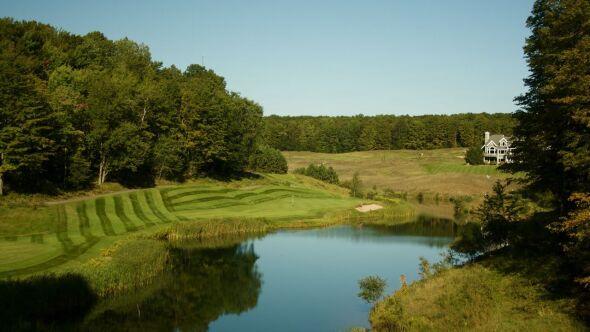
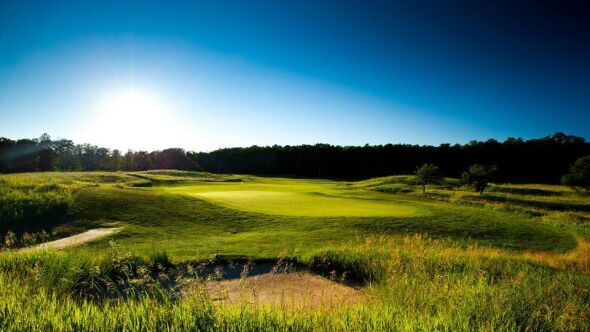

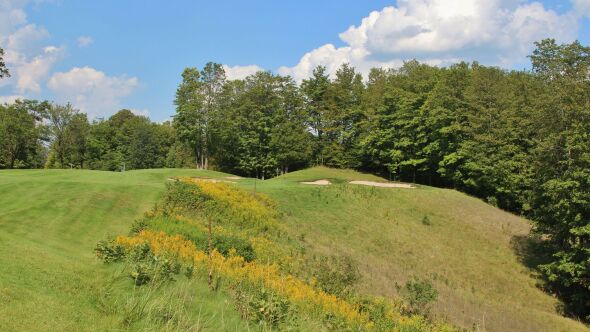






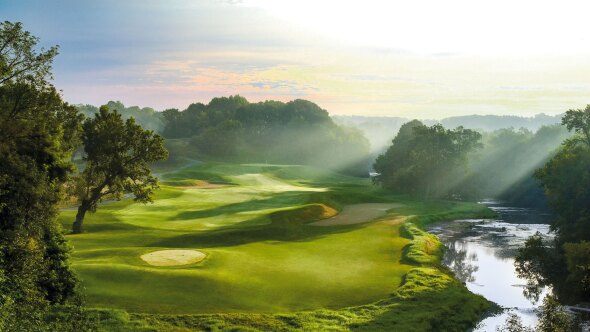
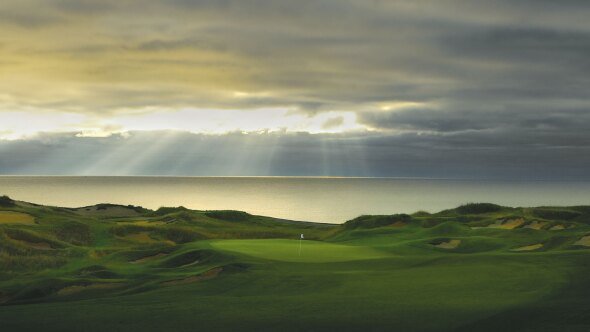


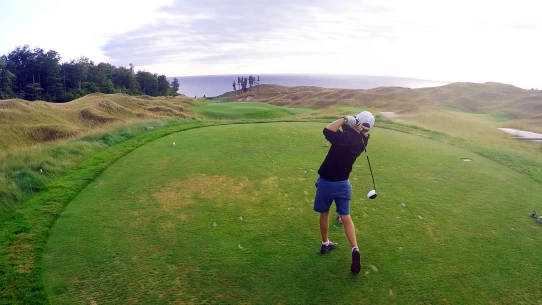

I believe this review is overly critical. I played the course on 16 June, only 11 days later and the greens were in great shape so I guess it's a tip of the cap to the grounds crew for turning this apparent "cow pasture" into a beautiful northern Michigan golf course in only 11 days. In fairness, there are places around the course where the cart path is not paved, but is that really a reason to discourage people from playing this gem of a course? I guess Golf Digest must have it all wrong by ranking this course as one of the top courses in Michigan. The tee boxes on a few holes were a bit "organic" but no where near as unplayable as this reviewer suggests. I hear what is being said about a course costing $100+ and expecting better conditions, but you will miss out on a great golf course if you decide to skip this course based on what I think is over exaggerated information.